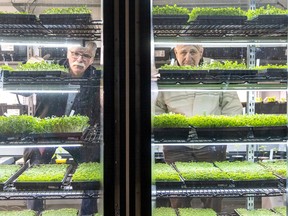From where the food comes to where it goes, the London Food Bank is making new plans to ease food insecurity in the region.

From where the food comes to where it goes, the London Food Bank is making new plans to ease food insecurity in the region.
Advertisement 2
Article content
From where it comes could soon include a complex of high-tech container greenhouses that can produce 500,000 fresh food servings a year.
Article content
Where it goes will include the homes of hundreds more Londoners through increased support of social service and anti-poverty agencies.
“Food insecurity looks like it’s going to be the way of future. The answer is not more and more people giving. The answer is that London becomes a food city,” Glen Pearson, co-director of the food bank, said at the launch of the annual spring food drive Thursday.
London needs to “stop looking at always trying to help hungry people and start finding ways to make food accessible and affordable for people,” Pearson said.
The London and District Construction Association is doing just that, its executive director Mike Carter said at the food drive launch.
Advertisement 3
Article content
The association announced last fall it was donating a sea can — a 12-meter shipping container — and the labor and materials to create a “farm in a box” for the London food bank.
That plan has grown into two sea cans as part of a five-can complex on a site yet to be determined, with the public being asked to raise money for the other three, Carter said.
Each one would cost about $175,000, and he’s hoping to have some on a site by the end of the year, Carter said.
“We are encouraging the community to make this their own and do some really good food security assistance.”
Carter unveiled a plan using three containers with catchy names – Cabbagetown for leafy greens, Vineland for beans and climbing plants, and Superfood for micro greens – to supply fresh produce for Londoners.
Advertisement 4
Article content
A fourth would be dedicated to selling food to restaurants, the money from sales going to operate the rest, and the fifth for crop support.
The containers would be high-tech, intensive growing machines, and the association already has set up a lab at the food bank to test-run software and techniques.
“It’s an opportunity to grow more in the city, for everyone,” said Louis Reyes, the food bank’s director of greenhouse operations who is overseeing the tests.
Recommended from Editorial
In the past five years, the food bank has invested in a greenhouse operation and helped other organizations set up their own. Donations to annual food drives have remained strong.
Advertisement 5
Article content
“The public has been incredibly generous. Whatever the public can give we always find amazing,” food bank co-director Jane Roy said.
But the number of people seeking monthly food hampers at the central and neighborhood depots has doubled during the past two years, Roy said.
“We’ve never been a busier,” she said.
That increase doesn’t include the needs of dozens of agencies that also receive supplies from the food bank, she said.
Organizations that provide food and meals to people have faced cuts in donations and increased demands, Pearson said.
“We just give out food,” Pearson said. “We don’t help people with counseling, with English as a second language, helping people get back to work, find places to live. Those other agencies do that and they deserve all the support we can give.”
Advertisement 6
Article content
The food bank is spending about $2.8 million during the next three years, money it received and saved during the pandemic, to help those agencies that also provide food and meals.
Among them is Sanctuary London, a non-profit helping people struggling with homelessness.
“It’s not that givers have declined, but our needs have compounded,” executive director Darryl Reckman said at the food drive launch.
The weekly dinner that used to draw 150 people now attracts more than 300, he said.
Also at the food drive launch was Kim Loupos, a public health dietitian at the Middlesex-London Health Unit, who co-ordinates several food programs for dozens of organizations.
The food bank is increasing its funding for the programs during the next three years, she said.
Advertisement 7
Article content
“Everyone in our community should have access to a nutritious, acceptable and culturally acceptable diet,” Loupos said.
London Food Bank’s 37th annual spring drive
- March 22 to April 1
- Non-perishable items accepted at major grocery stores
- Food drive bags available at stores, or people can use their own
- Financial donations at www.londonfoodbank.ca
- At least 60 per cent will go to other agencies
- 41,362 kilograms (91,187 pounds) received in food and financial equivalent last year
Food bank needs
- 65,188 hampers distributed in 2023, up 41 per cent from 2022
- 38,775 individuals helped in 2023, up 32 per cent from 2022
- 46 per cent of customers were new last year, compared to 36 per cent in 2022
Article content

